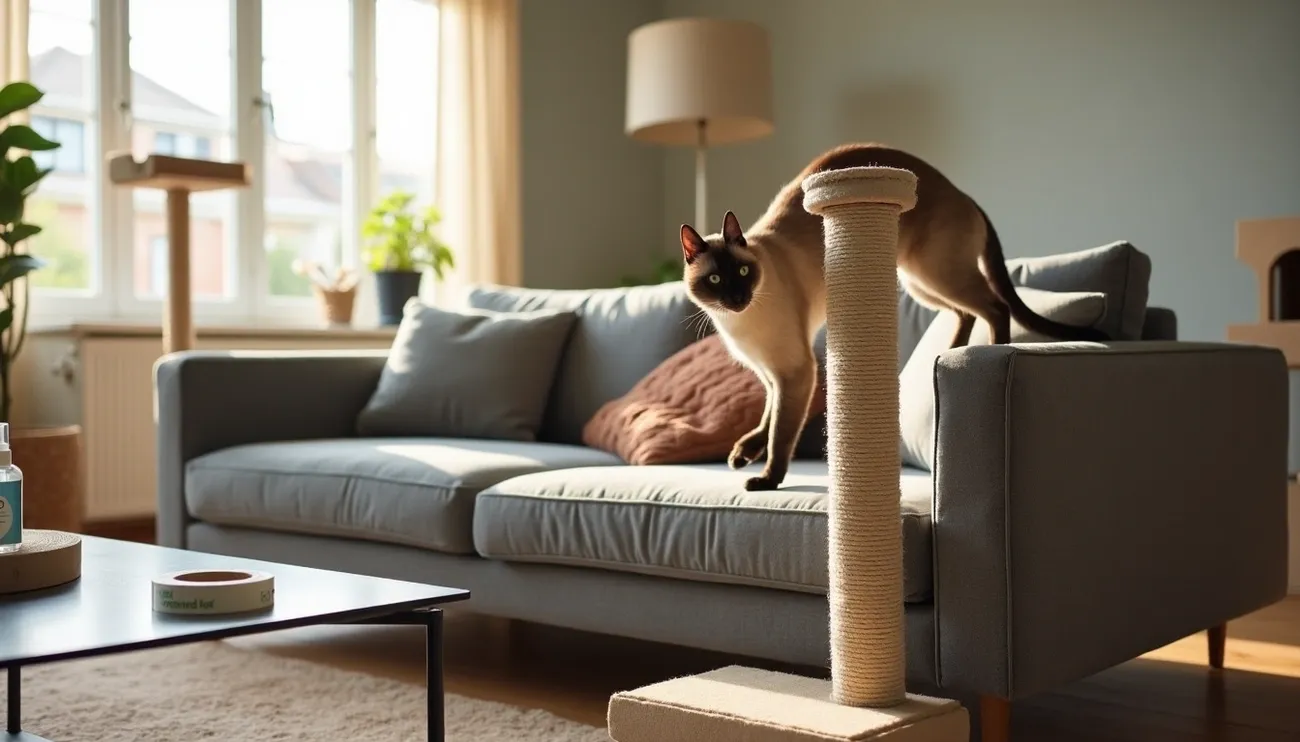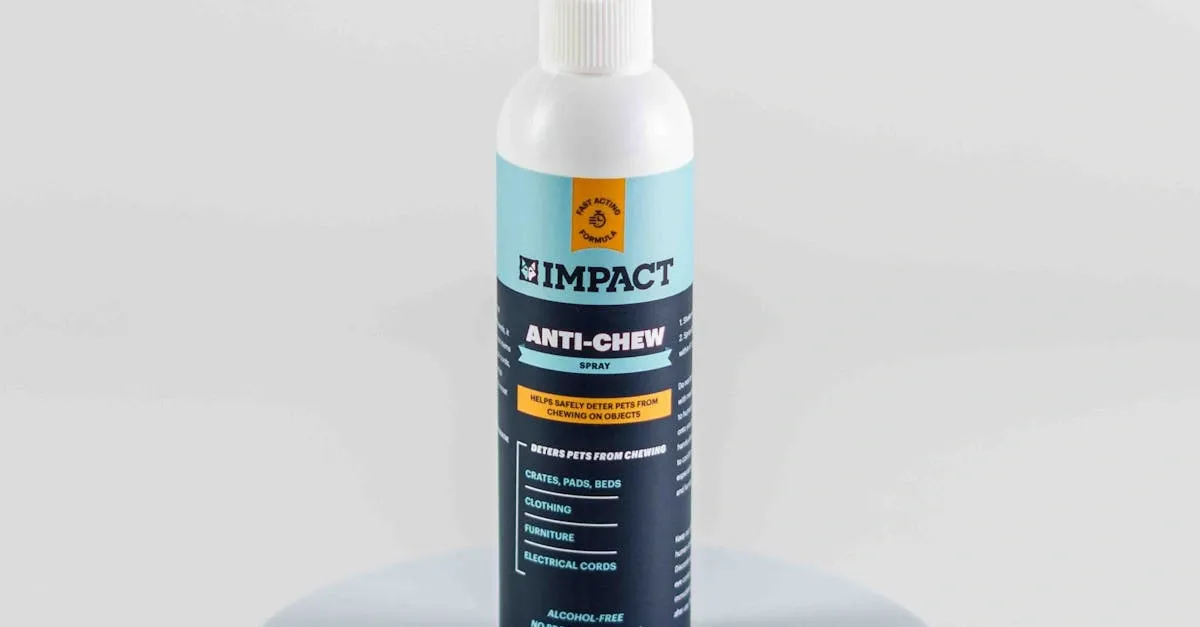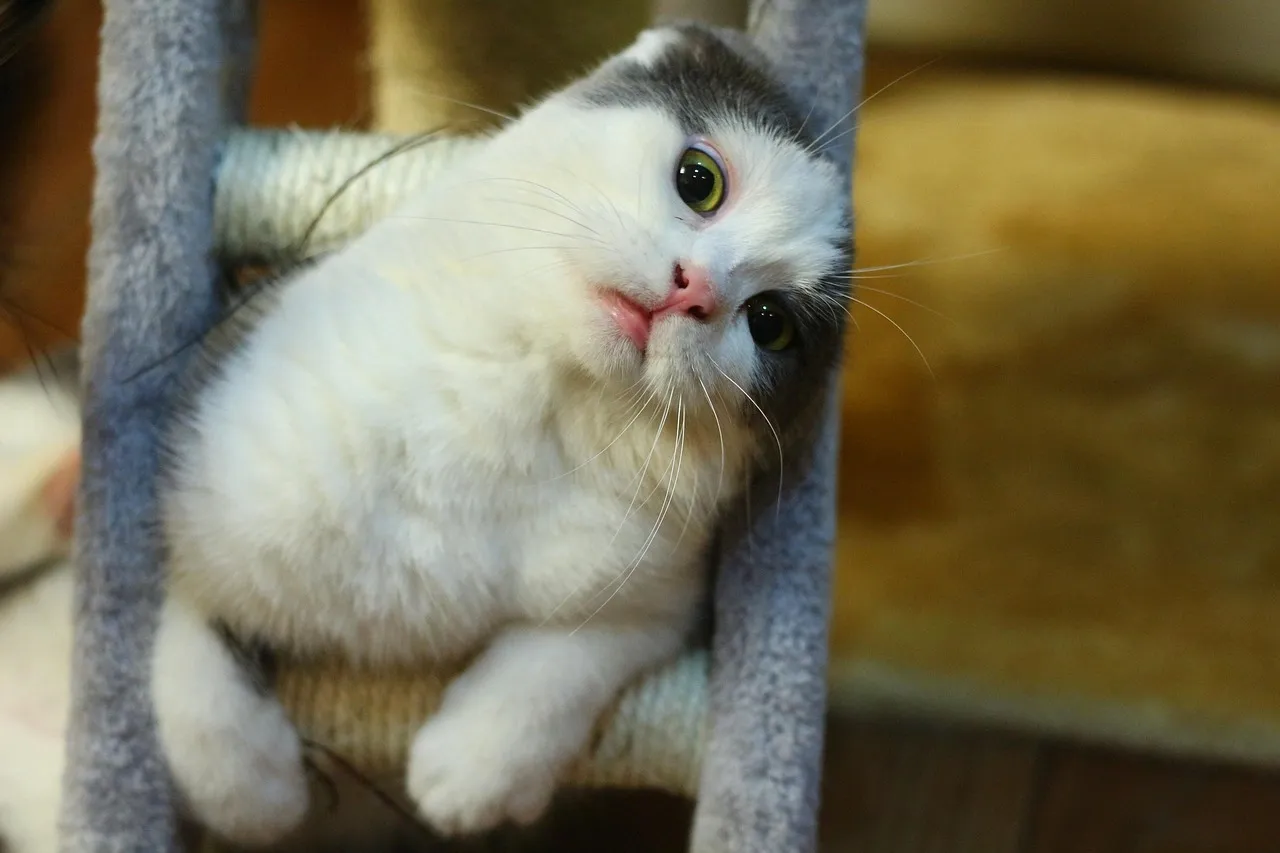Table of Contents
- Why Cats Scratch Furniture and How It Affects Your Home
- How to Stop Cat Scratching Furniture with the Right Tools
- Choosing the best scratching post material
- Vertical vs horizontal scratchers
- How to protect furniture from cats using scratch boards
- Training Your Cat to Use Scratchers Instead of Furniture
- How to Prevent Cats from Scratching Furniture with Deterrents
- Advanced Cat Care Tips for New Owners: Enrichment and Anxiety
- Final Thoughts – How to Stop Cats from Scratching Furniture: Expert Tips That Actually Work
- Final Thoughts – How to Stop Cats from Scratching Furniture
- FAQs
This blog post may contain affiliate links. As an Amazon Associate I earn from qualifying purchases.
How to Stop Cats from Scratching Furniture: Expert Tips That Actually Work

My cats started scratching at just 8 weeks old. After years of trial and error as a cat owner, I learned the best ways to stop cats from scratching furniture. The behavior might seem destructive, but your kitty follows deep instincts that serve many purposes.
My couch bears the marks of my cats’ territory claims. They leave visible claw marks and invisible scent marks from special glands in their paws. The scratching helps them keep their claws sharp – a vital skill for hunting and self-defense. On top of that, it lets them stretch their muscles and feel calmer by releasing soothing chemicals in their brains. But knowing all this doesn’t make my damaged furniture any less frustrating!
You’ll find great solutions here if your furniture needs protection from cat scratching. The tips I’ve gathered really work to stop the scratching without disrupting your pet’s natural behaviors. This piece covers everything from picking the right scratching posts to using safe deterrents. These methods will save your furniture and keep your feline friend happy at the same time.
Why Cats Scratch Furniture and How It Affects Your Home
Cat owners know that sinking feeling when they find fresh claw marks on their favorite furniture. Learning why cats scratch furniture helps new owners develop ways to stop this behavior. Your cats aren’t trying to destroy things – they simply follow their natural instincts.
Territorial marking and scent glands
Your cat’s paw pads contain special scent glands that release unique pheromones with each scratch. These invisible chemical signals work like personal identification stamps and send vital information to other cats.
“Think of it as your cat’s version of leaving a business card,” I often tell new pet parents.
Your cat leaves their mark on your sofa or doorframe to claim territory. These scratches create both visible and invisible markers that tell other cats about:
- Health status
- Reception to mating
- Territory boundaries
- Security and familiarity
- Relationships with other cats
Your cat chooses busy areas of your home because these spots offer the best communication value. This explains why your favorite armchair becomes their target.
Stretching and nail maintenance
Scratching serves vital physical purposes. Cats need to scratch because it helps them:
- Remove outer husks and dead nail fragments
- Keep their claws sharp and at a good length
- Stretch their bodies fully to stay flexible
- Work out muscles in their paws, legs, shoulders, and back
My cats always stretch and scratch right after napping. This behavior gets their bodies ready to run, stalk, and pounce – actions programmed into their DNA despite their cozy indoor lives.
Stress relief and emotional regulation
Understanding how to protect furniture from cats requires knowing that scratching helps cats regulate emotions. They scratch to:
- Ease stress and anxiety from indoor living
- Comfort themselves during environmental changes
- Feel secure in their space
- Show excitement or frustration
Do’s and Don’ts for Managing Cat Scratching
| Do’s | Don’ts |
|---|---|
| Place multiple scratching posts in social spots | Punish scratching with spray bottles or yelling |
| Pick materials cats love (cardboard, rope, carpet) | Expect one scratching post to fix everything |
| Use catnip or feline pheromone products on scratchers | Leave cats without enrichment activities |
| Let cats outside in safe environments | Think scratching is spiteful behavior |
Scratching helps cats stay healthy and happy – it’s not about destroying your stuff. The next section shares practical ways to redirect this natural behavior using the right tools and methods to learn how to prevent cats from scratching furniture.
How to Stop Cat Scratching Furniture with the Right Tools
The right scratching tools serve as your first defense against furniture damage. My years of trial and error have shown that cat care tips for new owners should start with picking the perfect scratching post to build a foundation for how to stop cats from scratching furniture.
Choosing the best scratching post material
Your scratching post’s material plays a big role in whether your cat will use it instead of your furniture. Your cat’s priorities make a significant difference.
Sisal ranks as the top scratching material for most cats. You’ll find two types:
- Sisal fabric – Provides a continuous scratching surface that shreds satisfyingly under claws
- Sisal rope – Durable but has gaps between wrappings that some cats find frustrating
“Cats prefer a sturdy material that shreds under their claws,” notes one expert source. This explains why cardboard scratchers remain popular despite lower durability – they give cats that satisfying shredding sensation they naturally seek.
Carpet-covered posts might create confusion. Your cat might not understand why scratching the post’s carpet works but scratching your floor’s carpet doesn’t. You should pick a material different from your home furnishings.
Vertical vs horizontal scratchers
Cats show clear favorites when it comes to scratching orientation. Some cats love vertical scratching while others prefer horizontal surfaces.
| Scratcher Type | Best For Cats Who… | Typical Materials |
|---|---|---|
| Vertical | Scratch furniture arms, doorframes, walls | Sisal, carpet, wood |
| Horizontal | Scratch carpets, rugs, mattress edges | Cardboard, sisal mats |
| Angled/Inclined | Enjoy both orientations | Various materials |
Height makes a huge difference for vertical posts. “Your cat should be able to stretch her body from her toes ALL the way up to her front paws,” explains one veterinary source. Cats love this full-body stretching experience during vertical scratching.
A stable post matters just as much. Cats quickly abandon wobbly posts, and falling posts might even scare them. Look for posts with wide, heavy bases that stay put during energetic scratching sessions.
How to protect furniture from cats using scratch boards
Smart placement of scratch boards can shield your furniture from damage:
Do’s and Don’ts for Furniture Protection
| Do’s | Don’ts |
|---|---|
| Place scratchers near furniture your cat targets | Hide scratchers in rarely visited areas |
| Use corner protectors on frequently scratched furniture | Use double-sided tape without providing alternatives |
| Try sisal-covered furniture protectors that drape over arms | Expect one scratcher to solve all problems |
| Consider wall-mounted options for space efficiency | Choose flimsy scratchers that wobble or fall |
Amazon offers specialized furniture shields for quick protection:
- Corner scratching posts that protect furniture edges
- Adhesive scratch pads that attach directly to furniture
- Clear protective panels that cover vulnerable surfaces
- Scratch-deterrent furniture covers with built-in scratching areas
The best approach combines multiple scratcher types throughout your home. “Most households need at least one of each style,” suggests one feline behavior expert, “so your cat can have options.”
Note that scratchers work best in socially active spots rather than hidden corners. Cats scratch in high-traffic areas to mark territory, so place your scratchers where cats naturally want to leave their mark.
Training Your Cat to Use Scratchers Instead of Furniture
Your home needs proper scratching posts before the real work starts – teaching your cat to use them. Training cats to stop scratching furniture is a vital part of cat care tips for new owners. Success needs patience, consistency, and positive reinforcement.
Step-by-step guide to positive reinforcement
Positive reinforcement rewards good behaviors so cats repeat them more. This method works great to change scratching habits. Here’s what I know works:
- Put your scratching post near furniture your cat scratches
- Give rewards right away when your cat uses the post
The reward must come within 3 seconds so your cat makes the connection - Skip punishment and ignore unwanted scratching
- Guide your cat to the post if they scratch furniture
Keep rewarding good scratching behavior
Your cat learns from repetition and steady training. A neutral response works best if you catch bad scratching. Make a soft sound or guide your cat to the right spot instead of yelling.
Using catnip and toys to attract interest
Most cats don’t see new posts as good alternatives to your couch. These attractants can help:
Add dried catnip to the scratching material or use catnip spray Transfer your cat’s scent by rubbing their paws on the post Play with wand toys near the post Try Feliway pheromone products made for scratching
My experience shows that hanging toys on scratching posts creates good memories. Cats scratch more during playtime.
Reward systems that work
Each cat responds differently to rewards:
| Do’s | Don’ts |
|---|---|
| Give rewards right after scratching (3 seconds max) | Reward bad behavior by accident |
| Mix up rewards (treats, play, pets) | Use only verbal praise |
| Match rewards to your cat’s priorities | Expect perfect behavior right away |
| Switch to random rewards later | Give up too fast |
Small kibbles make great treats that cats can chase like prey. This combines rewards with exercise and natural hunting instincts.
How to Prevent Cats from Scratching Furniture with Deterrents

Image Source: https://pexels.com/
Training and proper scratching posts are vital, but cat owners sometimes need extra help. Learning how to stop cats from scratching furniture takes an integrated approach. Here are some powerful deterrents that work with stubborn scratchers.
Safe sprays and scents cats dislike
Cats naturally avoid certain scents we can use as deterrents:
- Citrus-based sprays (lemon, orange) repel most cats effectively
- Rosemary and lemongrass essential oils (diluted properly)
- Commercial deterrent sprays containing herbal blends
- Pheromone products like Feliway Classic, which contains feline facial hormones
Spraying citrus scents directly on furniture works well quickly. Just test on a hidden spot first to avoid damage.
Furniture covers and sticky tape options
Physical barriers offer reliable protection against scratching:
- Drape blankets or plastic sheets over favorite scratching spots
- Apply double-sided sticky tape to targeted areas
- Use transparent furniture shields that adhere to surfaces
- Specialized anti-scratch covers designed for specific furniture types
Sticky tape proves remarkably effective since cats hate the feeling on their paws. These physical deterrents help guide your cat’s scratching behavior to appropriate surfaces when combined with training.
Do’s and Don’ts of using deterrents
| Do’s | Don’ts |
|---|---|
| Use motion-detection air sprays with gentle hissing sounds | Use declawing as a solution (painful and harmful) |
| Apply enzymatic cleaners to remove scent markers | Punish your cat with yelling or water sprays |
| Combine deterrents with positive reinforcement | Use shock mats or spike mats (causes fear) |
| Test sprays on a small spot before full application | Force cats physically to use scratchers |
| Use deterrents consistently for 2-3 weeks | Rely solely on deterrents without proper scratchers |
Installing scratchers near targeted furniture helps significantly. Odor-neutralizing enzymatic cleaners eliminate scent markers that attract cats back to the same spots.
Cat care tips should focus on humane approaches. Providing attractive scratching alternatives remains crucial to protect furniture long-term.
Advanced Cat Care Tips for New Owners: Enrichment and Anxiety

Image Source: https://pixabay.com/
Your cat’s scratching behavior can improve dramatically with solutions that go beyond basic scratching posts and deterrents. New cat owners should know that proper enrichment and anxiety management techniques make a significant difference in reducing furniture damage.
How enrichment reduces destructive behavior
Cats need mental stimulation and physical exercise through enrichment activities:
| Do’s | Don’ts |
|---|---|
| Provide puzzle feeders and food toys | Leave cats with nothing to do all day |
| Schedule 15 minutes of daily interactive play | Expect scratching posts alone to solve all problems |
| Create window perches for bird watching | Punish stress-related behaviors |
| Rotate toys to maintain novelty | Ignore emotional needs of indoor cats |
Enrichment doesn’t require expensive investments. Simple interactive toys from online stores can improve your cat’s mental state by triggering their natural hunting instincts.
Signs your cat is stressed
Your cat might be experiencing anxiety if you notice these signs:
Excessive scratching, especially in multiple locations Hiding or isolation from family Overgrooming, sometimes causing bald spots Inappropriate elimination outside the litter box Aggression toward people or other pets Changes in appetite or weight Heightened sensitivity to noises Increased watchfulness or startling easily
When to consult a behaviorist or vet
Medical conditions can appear as behavioral issues.
Professional help might be necessary if:
The behavior affects your quality of life Your cat’s scratching results in damage or injuries Multiple solutions haven’t worked Scratching continues for weeks or worsens
Final Thoughts – How to Stop Cats from Scratching Furniture: Expert Tips That Actually Work
Final Thoughts – How to Stop Cats from Scratching Furniture
My whole approach to furniture protection changed when I understood why our feline friends scratch. Cats aren’t trying to destroy things – they just follow their natural instincts that help their physical and emotional wellbeing.
New cat owners should focus on giving their pets proper scratching alternatives. Quality scratching posts made of materials cats love, like sisal or cardboard, should be your top priority. Placing these posts near your cat’s favorite furniture spots will boost your success rate by a lot.
Positive reinforcement makes training work really well. Your cat will learn quickly when you reward them right after they use their scratching posts. You can also use citrus sprays, sticky tape, and special furniture covers as temporary barriers while your cat develops better habits.
Your cat’s anxiety levels drop when you add enrichment activities to their routine. Puzzle feeders, interactive toys, and regular playtime give them the mental stimulation they need to reduce destructive behavior.
Note that patience and consistency will get you the best results. Protecting your furniture takes time and dedication, but you’ll end up with a better relationship with your cat based on understanding instead of frustration. These strategies will help your furniture and your feline friend live together peacefully without compromising anyone’s needs.
FAQs
Q1. What are some effective ways to stop cats from scratching furniture?
Provide appropriate scratching posts made of materials cats prefer like sisal or cardboard. Place them near furniture that’s frequently targeted. Use deterrents like citrus sprays or double-sided tape on furniture. Reward your cat for using scratching posts. Trim your cat’s nails regularly.
Q2. How can I train my cat to use a scratching post instead of furniture?
Use positive reinforcement by rewarding your cat immediately after they use the scratching post. Place catnip or toys near the post to attract interest. Gently redirect your cat to the post if you catch them scratching furniture. Be patient and consistent with training.
Q3. What scents deter cats from scratching furniture?
Cats generally dislike citrus scents like lemon or orange. You can use citrus-scented sprays or peels near furniture. Vinegar diluted with water can also be effective. Commercial deterrent sprays containing herbal blends are available as well.
Q4. How can I protect my furniture from cat scratching?
Use furniture covers or drape blankets over favorite scratching spots. Apply double-sided sticky tape to targeted areas. Consider transparent furniture shields that adhere to surfaces. Place scratching posts near furniture your cat likes to scratch.
Q5. When should I consult a professional about my cat’s scratching behavior?
Seek professional help if the scratching behavior persists despite trying multiple solutions, causes significant damage, or if it’s accompanied by other concerning behaviors. Always consult a veterinarian first to rule out any underlying medical issues that may be causing the behavior.
